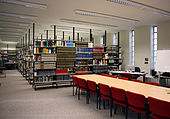Italian cultural institute Cologne
The Italian Cultural Institute (Istituto Italiano di Cultura) is one of the 89 cultural institutions in Italy worldwide and one of the four foreign cultural institutions in Cologne today . It is located in the Lindenthal district not far from the university .
history
Petrarch house
In 1931, shortly before the end of the Weimar Republic , the then Mayor of Cologne, Konrad Adenauer, founded the first German-Italian cultural institute in the southern Neustadt . It was built in Overstolzenstrasse on the edge of the Volksgarten and named after the Italian poet and historian Petrarca House (also Istituto italo-Germanico di cultura ).
The cooperation between the city and the Italian government manifested itself in the new Petrarca House of the German-Italian cultural institute and contributed to the cultural enrichment of the city. The head of the house in the years 1931–36 was the Italian scholar Arturo Farinelli (1867–1948). The Petrarca House was active until 1944. At the end of the last world war it was destroyed - probably by air raids .
An essential part of the institute's facilities was its extensive library. It is said to have included around 11,000 volumes as early as 1938. About 400 volumes of this collection survived the war and were thus able to form the basis of the library of the institute that was later re-established.
New building on Universitätsstrasse
On the edge of the inner urban green belt , a building complex was built according to the plans of the Cologne architect Hanns Koerfer in the style of Italian rationalism on a piece of land made available by the city on Universitätsstraße, which still unites the Italian cultural institute and the Italian consulate general .
The new building was opened on June 29, 1954 with a festive ceremony. Invited guests were Konrad Adenauer, who had now become Chancellor of the Federal Republic, the Italian Minister of Education Gaetano Martino and the Ambassador Francesco Babuscio Rizzo , the Archbishop of Cologne Josef Frings and other representatives of culture and politics in the city and the state.
With the signing of agreements between the city and the Italian state, which regulated the status of the institute in terms of mutual cooperation with local institutions, the Italian cultural institute was officially opened in the autumn of the same year.
Library of the Petrarch Institute of the University
The Petrarca Institute was revived as early as 1949 through the commitment of the Cologne Romanist Fritz Schalk and with the significant participation of the first Minister of Education, Christine Teusch , initially founded as an independent institute at the university.
The rescued holdings of the old institute still offer the opportunity for scientific research into the literature of Italy from the 14th to the 16th century. Literature acquisitions from the previous centuries were added to this focus, with classics among the Italian authors of the following period up to the end of the 19th century also being considered.
Today's facility
The cultural institute is located in a narrow residential street parallel to Universitätsstraße. In the 1970s, the building was expanded by an extension for the Petrarca Institute assigned to the university. The building layout is U-shaped, with the street front being offset in two steps to the north. The side wings attached to the west border a non-public garden area, the northern wing on Danteweg stands parallel to the open Lindenthal Canal that begins on Universitätsstrasse . Like the front, these buildings are also built on two floors. The entire complex shows the typical flat roof architecture of the 1950s and is a listed building .
Today's library
The institute's library has a stock of around 18,000 books, particularly on Italian literature and cultural studies (also in German), as well as magazines, newspapers, documentary videos and slides. Textbooks and publications accompanying the course are used for language acquisition. Borrowing is possible upon presentation of an identity card.
- Interior design
The interior of the institute building contains on the ground floor a large foyer with a staircase, the elongated library room, reading or classroom and a number of office rooms that can be reached via corridors. The walls are whitewashed and are used for changing exhibitions in the foyer and in the corridors. The architecture is repeated on the upper floor, whereby the large room there is a theater equipped with complete stage technology and seating around 250 people .
tasks
The main task of the institution is to promote and maintain the cultural cooperation between the two countries and, in particular, the dialogue between the people of both nations . With a wide range of events in the fields of art, music, literature and theater, as well as contributions to discussions on current political or cultural issues, the institute tries to provide an overview of the past and present of both countries. Another focus of the institute is the promotion of the acquisition of the Italian language , u. a. with the implementation of language courses in small groups or individual lessons.
Web links
- Italian cultural institute Cologne
- Documents and newspaper articles on the Petrarca House in the 20th Century press kit of the ZBW - Leibniz Information Center for Economics .
Individual evidence
- ↑ History of the institute
- ^ Library of the Petrarca Institute of the University of Petrarca Institute, Library, Book and Information Sciences
- ↑ Petraca Institute of the University of Cologne
Coordinates: 50 ° 56 '4.9 " N , 6 ° 55' 25.9" E






